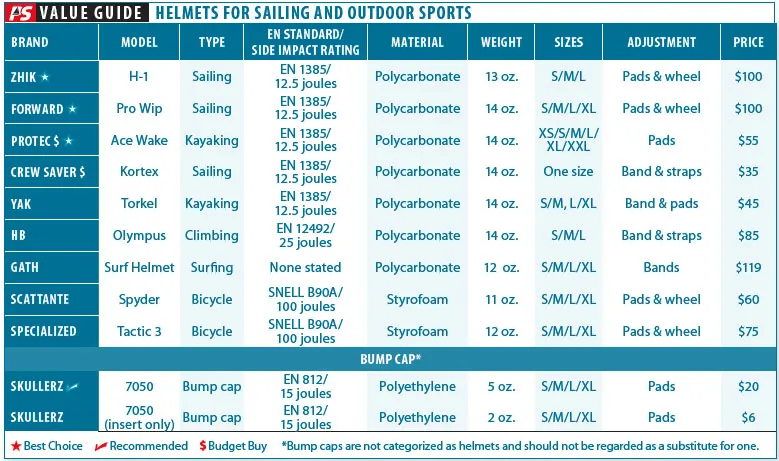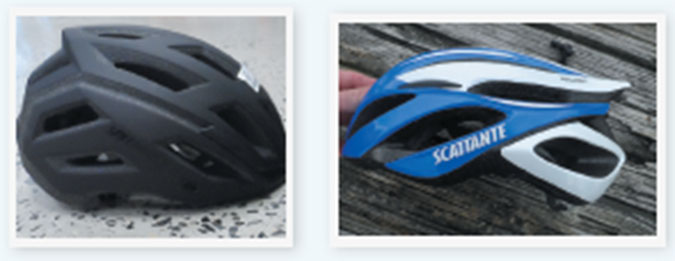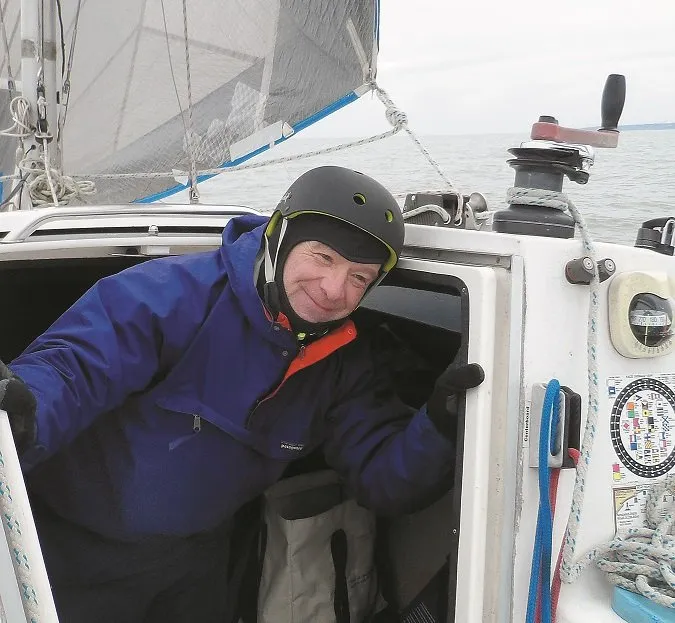Head protection has become a hot topic among sailors. Volvo Ocean Race helmsman wear surf helmets with retractable visors. Americas Cup crew wears them, along with body armor and breathing equipment. Amateurs in high performance beach catamaran and dinghy classes are adopting them in big numbers, and some youth, college, and Olympic sailing programs have made them mandatory, like PFDs. Even cruisers are beginning to wonder about trips up the mast, heavy weather sailing, and even routine bumps. Is it the new thing, or just transition period until we work out where they make sense?
A review of offshore racing accidents places head injuries high on the list of serious injuries (6 to 11 percent). In fact, one-third of all retirements and rescues are for head trauma, and nearly as many fatalities are from brain injury as drowning. And then there is the unanswerable question of how many of those drowning victims received a knock on the head on the way overboard.
Even with a self-righting PFD, the odds of inhaling water go up when you are unconscious, and most dinghy sailors wear buoyancy aids that do not keep your face out of the water. Finally, there are the scalp injuries, bruises and minor concussions, many of which go unreported. Racing is a contact sport.
We found cruising statistics impossible to evaluate. More than a few of the fatal MOBs we researched included a bang on the head, perhaps not enough to leave evidence, but enough to daze the victim. Most of our research relied on anecdotes and our own near-escapes with the boom.
Helmet Effectiveness
Can a helmet actually help? Research data from bicycling, football, and other sports tells us that a well-made helmet can prevent most scalp lacerations and skull fractures. On the other hand, it is less effective at preventing a concussion.
The brain is mostly water and can tolerate a direct strike to the forehead far better than it can a strike to the side, which will cause the head to spin. Thus, the same boxer who withstood blows to the forehead can be put to sleep or even killed by a single blow to the temple.
A helmet-football or bicycle or sailing- can potentially increase rotation, either by snagging on something or through sheer size. Design is key.
A helmet with a rigid, attached bill, or anything that can snag lines or catch water during a dive or fall into the water is a problem. A sailing helmet must float, stay in place, and not obstruct vision or hearing.
Among non-professionals, dinghy racers, especially youths, are among the early adopters, and this makes sense. Dinghies have light booms, so a helmet is more likely to help. Children and young adults are more prone to concussions than adults. And the risk is there. When racing, its easy to get distracted rounding a crowded leeward mark.
Helmet Standards
Sailing helmets are so new that there is no standard strictly for sailing. Instead, the standard that applies to racing sailing is adopted from helmets for other sports. Most dedicated sailing helmets meet EN 1385, a standard developed for whitewater kayaking.
One could use a helmet designed other sports, but some are poorly suited for sailing. Construction helmets (hard hats) can protect against strikes at the top of the head, but the crown is typically 1.5-inches high and they arent designed for side impact. Bicycle helmets are light and give good protection against hitting the ground, but they offer less side coverage and can snag. Mountaineering and rescue helmets are tested with 2-4 times great impact energy, but may be more bulky. The adjacent table indicates the side-impact limits for the respective helmet standard.
How We Tested
Since drop testing is well covered by standard lab tests, we chose to focus on practicality and observation. We took a variety of helmets sailing, and put them through a range of tests-including a simulated fall off our test boat. We tested the fit on a variety of wearers, and shoved the helmets from side and front to see how well they stayed in place. We also tried them in other activities, including skiing, biking, and kayaking.

Observations
Only the Zhik H-1 felt truly compatible with standard foul weather gear. With the others, a drysuit or dinghy smock works better.
None of the helmets interfere with hearing, but as wind picks up it becomes harder to hear. The cycling helmet, mountaineering helmet, and most sailing helmets impacted hearing, while the Zhik helmet had little noticeable effect.
Helmets with vents and a free-floating suspension are cooler. The Zhik H-1 helmet was the warmest of those we tested, but not uncomfortable if a breeze was blowing. Frostbiters can tape up the vent holes in winter. Make sure your helmet is comfortable over a thin balaclava.
Fit is critical. The YAK and HB helmets use a band around the brow and straps over the crown, similar to hard hats. These can be adjusted for both the depth of the head and diameter of the brow, allowing one-size fit and superior ventilation. Most bicycle helmets, like the ones that we tested, need to match the shape of your head. Dont go by appearances or what we recommend-try them on. Take your sunglasses and any thin hat or balaclava you may wear.
Zhik H-1
The rear dial allows rapid adjustment head circumference and hats, and fit pads allowed a close fit, making it one of the most stable helmets. Wind noise is reasonable and the close fit reduces line snagging, something we see as a significant hazard. It is the only helmet that worked well with hoods. The only down sides are limited ventilation and a small increase in wind noise at certain angles.
Bottom Line: Versatility makes it our Best Choice for most racing.
YAK Torkel
Sharing the same shell as the Crewsaver Kortex, the Torkel varies in the details of the suspension and the ear protectors. Instead of relying on foam pads to position the shell, the shell is suspended from webbing straps, with back-up padding for side impacts. This design approach is common and well proven in industrial hard hats and provides the best fit in the group. Additionally, the harness is free-floating, similar to the MIPS systems that are being introduced in bicycle helmets. Since most concussions result from rotational rather than a direct impact alone, this may improve protection. The ventilation was superior. On the downside, the suspension is time consuming to adjust. The padded ear protectors are a mixed blessing; they can rub lightly, depending on how far your ears stick out, but they also increase the protected area.
Bottom line: The Kortex is a better choice.
Crewsaver Kortex
An improved suspension and strap arrangement make this a better choice for sailors and most other uses. Good ventilation made it comfortable all-day.
Bottom line: A Budget Buy.
Protec Ace Wake
Low price is the result of mass production, not low quality. Protec has 45 years of experience and has probably made more helmets than all the others combined. It offers the most protective area, featuring a strong shell, thick graduated padding, full coverage, and a stable suspension system. The removable wakeboarding ear guards keep water from pounding your eardrum at 40 knots, but we took them off for testing. We spotted these on the AC Oracle Team; the lowest wind noise of the group was probably a factor. Sizing runs a little small.
Bottom line: Our Best Choice for high-speed sailing.
Forward Pro WIP
The only helmet in the group to be constructed similarly to bicycle helmets, with a Styrofoam liner bonded to a thin shell. This approach holds the promise of lightweight and improved impact reduction. Although fit varies between wearers, this is perhaps the most comfortable. Wind noise was less than most and it fit most hoods. The Forward Whip is perhaps the most popular with classes, clubs, and small boat sailors in general.
Bottom line: Another Best Choice, based upon all-around performance.
Gath Surf Helmet
Most close fitting surf helmets are not EN 1385 approved and offer rather limited protection. They are designed to protect against surfboard whacks and coral rather than falls. Forehead protection is limited, but they do feature a neoprene forehead gasket to keep water from draining into your eyes. That said, Gath does make more protective helmets, like he rescue-oriented Gedi. The RV (retractable visor, $189) has attracted a high end following, since it keeps out heavy spray.
Bottom line: PS did not test this helmet. If you need the visor, check it out.
Olympus Climbing Helmet
Representative of many climbing helmets, the one (now out of production) was the standard for mountaineering for decades. The hard-hat style suspension provided a custom fit, with straps made from strong nylon webbing instead of plastic. It has a smooth profile for wear under hoods, does not snag on ropes.
Bottom Line: Optimized for strikes from above, they are not as well suited for the sailors needs. Built for a different purpose.
Scattante Spyder
A standard bike helmet, this performed poorly in nearly every category other than ventilation.
Bottom line: Not recommended.
Specialized Tactic 3
With better back and side coverage and excellent resistance to shifting, this helmet is more comfortable and may offer better protection than any sailing helmet. The down side of increased padding is that it is a bulkier and more prone to snagging.
Bottom line: Mountain bike and urban-style bike helmets with a smooth profile should be strong contenders.
Bump Caps
A helmet only works if you wear it, and for most day sailors and cruisers, it would take very special circumstances (heavy weather or a trip up the mast) to make us pull one on.
It is important to note that these are NOT hardhats or helmets by any stretch of the imagination. Although approved under a standard (EN 812), their only purpose is to protect workers from minor bruises and scalp injuries from static objects when working in areas with low ceilings and low hanging obstructions. There are even inserts that can be slipped inside you favorite hat.
Bottom line: These wont offer much protection against a hard whack, but are convenient for cruising sailors who are tired of getting welts from colliding with the companionway.
Conclusions
Times have changed, the reality of brain injuries has become better understood, and the trend toward better head protection is clear.
Do sailing helmets help? Evidence shows that helmets can’t prevent concussions, and this is the justification US Sailing uses to avoid making them mandatory. But just because protective gear doesn’t fully prevent any injury doesn’t make it useless. Helmets can and do provide a measure of protection for any number of potential head impacts.
We like the Zhik H-1 for its slim fit and stability. The Protec ProAce offers superior protection and low wind noise. We like the Kortex for youth sailing, in part because it can fit a wide range of growing kids. If you have a bike helmet, it could be a valid choice if it offers sufficient side and back coverage and stays on well. Urban and free-ride helmets tick a lot of the right boxes, are tested to a higher impact standard, and are more likely to offer all-day comfort. Fit will always be a matter of personal preference and different types of sailing may have different protection requirements.
A helmet is generally overkill for the cruising sailor, but we wont call it silly on the foredeck with a spinnaker pole, in strong weather, or up the mast. Although we know it only protects against scalp cuts, tester Drew Frye often wears the Skullerz Bump Cap liner inside his favorite ball cap for aggressive day sailing.
No, you may not be ready to add another layer of protective gear for a day sail, but when conditions get wild or on boats that hit double digits speed, a sailing helmet is certainly something to think about.

Developed for whitewater paddling, white water paddling helmets meeting the EN 1385 standard must have a shell that can withstand multiple low-speed impacts with rocks as a kayaker drifts inverted downstream. Only minimal padding is required because the speed is low, but toughness over multiple impacts and in surf is required. It must drain quickly, and it must float.
Bicycle helmets, on the other hand, must withstand a single blow with 4-8 times more energy (measured in joules, see adjacent table). However, because the emphasis is on ventilation and shock absorption during a single hit, the structure of a bicycle helmet is Styrofoam, with only a thin bonded shell to keep the bits together during the crash. Perhaps a new standard is needed, or perhaps helmets from another sport are more applicable.
The shortcoming of traditional road bicycle helmets is that some do not come down very far around the ears and the back of the head. However, many newer designs, especially those for mountain and urban biking, offer similar coverage to sailing helmets.





































How many joules is getting hit in the head with a boom on a racing dinghy? Why do the bike helmets have a rating of 100 joules vs 12.8 for sailing helmets? Is getting hit in the head by a boom more than 12.8 joules? I’m letting my 12 year old daughter compete in a dinghy regatta this weekend, and I would get her a sailing helmet vs a bike helmet, except for the fact that 12.8 joules sounds like minimal protection. What am I failing to understand here?